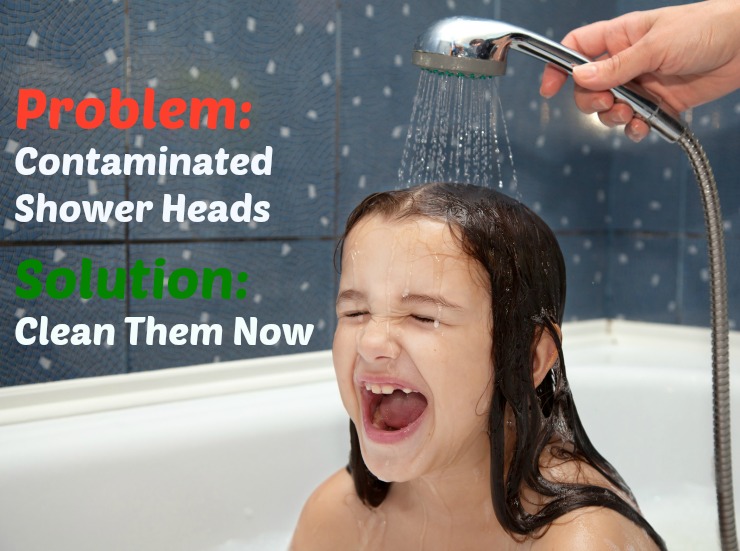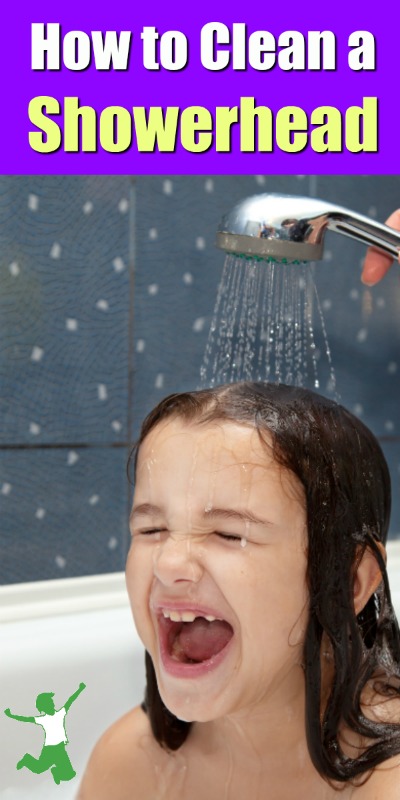One of the dirtiest things in the bathroom is the showerhead, which can get contaminated with an illness causing bacteria that is easily cleaned out with this simple method.
Did you know one of the dirtiest, most disgusting things in your entire home is the innocent looking shower head in your bathroom even if you use a water filter?
This is because shower filters are designed to remove chemicals like chlorine, not necessarily harmful microbes.
In fact, the typical shower head is probably far more contaminated with pathogenic bacteria than the toilet or sink in the same bathroom!
And to think many of us stand under it most days with water cascading over our heads and even straight into our open mouths if we prefer brushing our teeth while showering.
If this is news to you (it was to me!), you are definitely not alone…
Most people have no idea that a showerhead regardless of the model used is a favorite and very common breeding ground for a dangerous microbe that is on the rise.
Researchers call it atypical mycobacteria. But, no need to panic. You can fix the problem today and never worry about it again. Read on!
What is Atypical Mycobacteria?
Atypical mycobacteria are a very common group of microbes that surround us in the natural environment all the time. They are found in the water and soil. However, they can also be found in the air when they become aerosolized into droplets of water small enough to enter the tiny alveoli of the lungs such as what occurs during showering.
Despite being in the same family of bacteria as tuberculosis, atypical mycobacteria do not cause this deadly respiratory disease.
These pathogenic bacterial strains can, however, cause other types of serious health problems particularly when those exposed are already suffering from a weakened immune system or underlying illness. Atypical mycobacteria can cause infections of the skin, lungs, sinuses, lymph nodes, and other parts of the body.
Open wounds are particularly prone to infection from atypical mycobacteria. One species, M. paratuberculosis, is implicated in the development of Crohn’s disease (1).
On the positive side, person to person transmission of an infection with atypical mycobacteria does not occur with the exception of the strains that cause skin lesions. These include M. kansaii and M. simiae (2).
A Shower Head Full of Mycobacteria is a Health Hazard
Normal exposure to atypical mycobacteria in the environment would normally be in very small doses. In these natural situations, risk of infection is very small to nonexistent and would serve to boost immunity rather than cause infection.
However, when a shower head is contaminated with it, exposure can be frequent, intense, and completely overwhelming to the biological systems (3). This is especially true for young children whose immune systems are not yet fully developed.
Showering day after day with these pathogenic microbes pouring all over our skin, into our eyes, nose, and mouth is going to be a problem to our health, the only question is when.
All of us have days when our immune system is depressed for whatever reason. It could be a lack of sleep, an illness which has taken hold temporarily, or stressful family or work situations.
Symptoms of infection with atypical mycobacteria include coughing, breathing problems, and increased mucous production. Fever and overall weakness can present as well. Unexplained weight loss can also occur in extreme situations.
Solve Your Shower Head Issues TODAY
The best thing you can do to prevent atypical mycobacterial infections in yourself and your family is to treat the shower head like anything else in your bathroom: something that needs to be cleaned!
The showerhead cleaning process is simple, and you don’t have to do it that often. Every six months will do just fine!
Here’s what to do:
Shower Head Cleaning Protocol
Every six months, simply fill a sturdy plastic bag with distilled white vinegar (preferably nonGMO white vinegar … conventional is made from GMO corn!) and attach one to every shower head in your home. Large rubber bands can be used to secure the bags tightly.
If it’s easier, remove the showerhead completely and soak it in a bowl of vinegar.
Leave the showerhead soaking in the vinegar for an hour or longer. Do not reuse the bag or the vinegar for other showerheads in your home. In other words, use a fresh bag (or bowl) of vinegar for each shower head that needs to be disinfected.
Finally, remove the bags, dump the vinegar down the sink and run the shower heads to thoroughly flush them out.
Below is a helpful graphic of what to do that you can print out and stick on your refrigerator to remind you if that helps. Another idea is to schedule your twice per year showerhead cleanings at the same time you replace the batteries in your smoke alarms.
Thank you to Mark and Celeste of The Frank Clinic of Chiropractic for sharing this helpful graphic and green living tip that all of us can benefit from!

When I found out this information for the first time, I have to admit that I was more than a little grossed out! I immediately soaked our home’s showerheads as instructed.
Will you be doing the same?









What about the bath faucet? Seems like that would have the same problem, right? How would that be cleaned?
Unfortunately 2 men who had gone into remission after being treated for cancer at different hospitals here in the UK, had a shower before going home, & caught Legionares Disease from bacteria in the shower heads & died, after reading this I have bought cheap showerheads (£4 = $5.79) & change them monthly, I also empty the water out of the hose to the shower head after I shower so it doesn’t stagnate, yes I know, I’m being overly cautious 😀
Thank you Sarah. I always wondered about the shower head. I JUST DID it. I feel so much better lol.
Mycobacteria are implicated in almost ALL autoimmune dis-eases, according to research I read in “Nourishing Broth” – although that focussed on arthritis.
Question: I have the made in America Act o matic self cleaning shower head and a house filter system that includes UV light to kill bacteria. Do I still need to do a separate cleaning myself?
Perhaps not. Sounds like a very complete system, but I would double check with the manufacturer to be sure. It certainly wouldn’t hurt to soak the showerheads in vinegar periodically. It’s not a big effort or cost to do so.
Hi Sarah! I am glad to know about this fixable problem. …..but what about the kitchen faucet. It has a sprinkling option like the shower. What makes that safe?
Good idea to soak the kitchen sprayer too, but it doesn’t hold the same level of risk because you aren’t using it to shower water over your head, eyes, nose and mouth and breathing in the aerosolized droplets into the lungs.
Sarah you have such a way with words. The first line cracked me up! Then I read on and was thoroughly disgusted! Don’t know how you come up with such amazing material day after day.
If I weren’t renting I’d try the vinegar. Maybe gentle peroxide would be better for the finish in our case.
Anyway thanks for being such a great teacher and leader. This is definitely my favorite blog of all time.
LOL Glad you enjoyed the article and find the blog helpful (as well as entertaining!)
I have been working on this problem for over 3 years and finally came up with a common sense fix that is fool proof. I began when my mother was stricken with unexplained health issues including the ones mentioned in this article. Cleaning the inside of a showerhead is nearly impossible because you cannot see inside. The major manufacturers have known about this issue and have done nothing. So, I did.
What was your solution? The same as mentioned in the post?
I’m sorry but this just seems like a bogeyman; we’ve been showering daily for decades w/o a problem
Question … do you also not bother to clean your toilet, sink and shower because it hasn’t killed you yet?
I used to do this all the time until my brand new head was destroyed by the vinegar. It liked like metal, but the plastic thing was only coated with a paint which ate away the outside and ruined things inside.
What about cleaning it with peroxide? I’ve been favoring that over vinegar lately.
Peroxide would probably work fine too. Great idea. Don’t use bleach though.